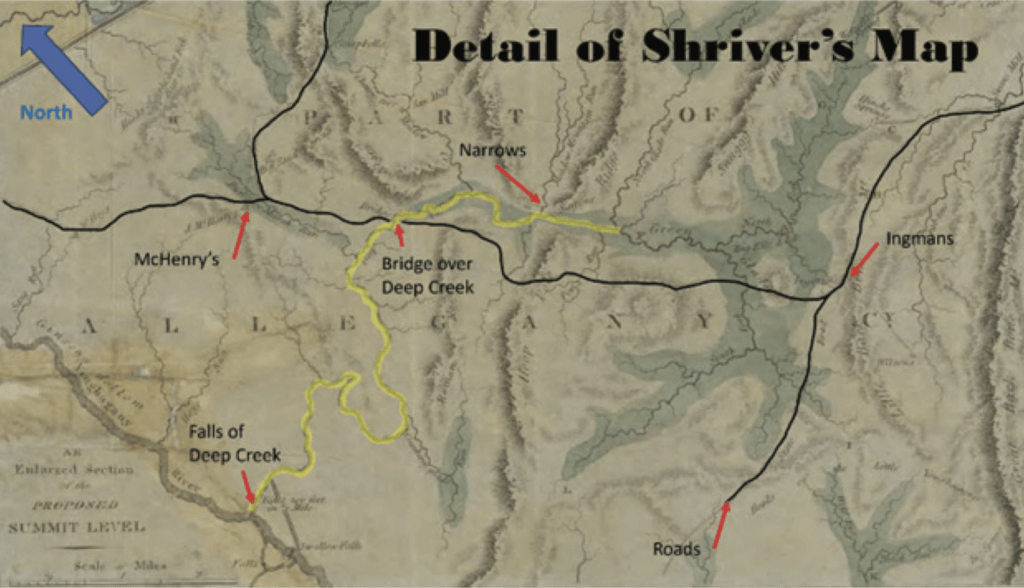Originally published by Chris Nichols of Deep Creek POA.
Deep Creek Lake has been such a fixture in Garrett County for so long, it’s tough to think about the time when it wasn’t there, but it used to be that there was just Deep Creek flowing through “The Glades” (the central part of the county) until 1925 when it was dammed to create the lake we know today. But there is a rich history of the area pre-1925 including two earlier dams on Deep Creek, a rock formation known as the “Devil’s Castle” and that the Glades was a vacation hotspot back in the early 1800’s. We’ll dive deep into the history of Deep Creek before the dam.
It’s unclear who first named Deep Creek and when that was, but it was indeed deep, about three to four feet for most of its course, which is unusual for streams in the area. From its origin around Sand Flat Rd to where today’s 219 bridge is, the banks were grassy and marshy. This area, especially the area between today’s bridges, was subject to flooding during heavy rains and snowmelts, creating an intermittent lake. As the creek passed the area of the 219 bridge, its course became more rocky with a thick coverage of mountain laurel and rhododendrons until it met the Youghiogheny River.
The first written mention of Deep Creek I have found is from one of the McHenry family letters dated 1818. Colonel James McHenry, the namesake of both the fort in Baltimore and the local town, was a prominent early inhabitant of the Glades. He was a physician, aide to General Washington during the Revolutionary War, and Secretary of War under two administrations. When he retired from public service, he established a seasonal lodge generally where today’s Lake Pointe Inn is today. Colonel McHenry wrote of the Glades in 1812 in one of his letters to a colleague:
“I like this country, its salubrious air, its mild summers, its interesting views made up of hills, woods, glades, streams, and mountains; above all, it delights me as affording me at my time of life, a salutary retirement from the busy world and its cares. I do not feel, therefore, dispossessed to wander further or to quit it in a hurry. Indeed, did it quadrate with the interest of the whole of my family to fix here, I should never move from the spot I am now.”
Col. McHenry’s nephew John McHenry, a lawyer, inherited the homestead there and was a full-time resident until he died in 1856. He also seemed to appreciate the special appeal of the Glades and the Deep Creek area, eschewing a more profitable career as a lawyer in Baltimore to the quiet country life. Several of his letters discuss the incredible trout fishing in Deep Creek, noting that visitors from Virginia caught more than 700 trout during an outing. John was also host to a number of other visitors to the area who shared their favorable impressions of the Glades.
James Shriver was one of these visitors. He was an engineer with the C&O Canal Company, and around 1823, he was commissioned to write a report on extending the C&O Canal past Cumberland to eventually connect with the Ohio River. Unfortunately for Mr. Shriver and the backers of the C&O Canal, the railroads superseded transport via canal and the plan never moved forward. But Shriver did a meticulous study of what it would take to get this canal past Cumberland, including a two-week visit to the Glades and John McHenry’s home to get on-the-ground data on this possible route. His final report included a very detailed map, with the proposed canal route to include a dam on Deep Creek to create a navigable lake generally from Crab Tree Creek to the Youghiogheny (getting from the Potomac River to Crab Tree would have required a tunnel under Backbone Mountain!).
Below is a detail of Shriver’s map from the 1824 report. The course of Deep Creek is highlighted in yellow and the main roads in black. Several interesting landmarks are also called out including the McHenry home, the only bridge over Deep Creek at the time, the Narrows (site of the current Glendale Bridge), and the Falls of Deep Creek. The green shading indicates the area that Shriver speculated would be flooded if the proposed dam were constructed.
In the text of his report, Shriver discusses the course and flow of Deep Creek, noting its unusual width and depth, the seasonal inundation of the creek during heavy rains, and an interesting phenomenon near McHenry’s named Boiling Spring that is now under McHenry Cove. He also details a remarkable rock formation near the Falls of Deep Creek that locals had named “The Devil’s Castle,” so named because the towering cliff seemed to be ready to fall on the viewer at any moment. It seems likely that these formations may still be in existence, although the flow of water of Deep Creek has been substantially diverted through the powerplant now and permission to access the area is unclear. However, the Falls of Deep Creek were documented in a 1909 postcard, reproduced below.
Another visitor to the Glades in the early 1820s was a hunting enthusiast named F.G. Skinner, who traveled the world and the US publishing his stories in a New York-based magazine. His visit to this area is preserved in a collection of his stories, Reminiscences of an Old Sportsman. Skinner was visiting a Scotsman named Campbell who was living in the Glades at the time (his home is noted on Shriver’s map as well). Skinner has one of the best descriptions of what Deep Creek looked like, in the context of duck hunting:
“Deep Creek runs sluggishly between steep banks, varying from three to five feet in height, and in the absence of these elevated banks there is a tall growth of wild grass, so that the fowler can approach the stream anywhere perfectly masked from the vigilant ducks until within half range of No. 6 shot…”
Skinner was also apparently an early “foodie,” waxing rhapsodically about a meal he had at John McHenry’s, saying “I here do most positively assert that never anywhere at any time have I eaten anything to compare with those fat flaky salmon-colored Deep Creek trout…” Skinner rounded out his trip with several successful hunting expeditions of the larger game and was amazed at the abundance of deer and bear.
Meshach Browning was another hunter in the area who had an appreciation of the large populations of wildlife in the area. He was also a settler of the Glades during the early 1800s and “neighbor” to Campbell and McHenry, though by several miles. Browning wrote the book Forty-four Years of the Life of a Hunter which details many of his hunting tales but also provides a rich description of what life in the Glades and what would become Garrett County was like in the early 1800s. He and his wife Mary had several homesteads throughout the area, one of which is generally around the site of the current McHenry Community Park. Many of Browning’s hunting tales take place around Deep Creek, including a story of him “spotlight” hunting deer with a shuttered candle lantern from a canoe on Deep Creek at night. The trip was cut short by a bear who jumped out of the grassy banks, capsizing Browning, but not before he got off a shot into the bear which was later tracked down and harvested.
While some of Browning’s hunting tales may strain credibility, his appreciation of the natural beauty of the area rings true in his description of the area that would become Deep Creek Lake:
“My mind cannot imagine a more beautiful sight than could be obtained from the highest grounds of the Hoop-Pole Ridge, which commanded a view of the valley between that and the great Back-Bone . . . It was a grand sight to watch the tall grass, rolling in beautiful waves with every breeze that passed over its smooth surface, as well as the herds of deer skipping and playing with each other”
After this flurry of coverage of the Glades from the McHenry’s, Shriver, Skinner, and Browning in the 1820s, the area seemed to go quiet until the 1870s when state and national levels of interest grew in protecting natural fisheries.
Part 2 of this article will cover the two dams that were built on Deep Creek before the current one and what kind of activity was going on here right before the dam was built. For more detail on Part 1 (and the rest of the story if you just can’t wait) visit https://dimesy.com/2024/03/09/before-the-dam-life-in-the-glades-before-deep-creek-lake/ for high-resolution maps and images and links to all of the sources for this article.
About the author: Chris Nichols is a Garrett County native, now living in the log cabin his grandparents built on Narrows Hill in the 1930s. He is a real estate agent with Taylor Made Deep Creek Sales and is active in the community, currently serving as the Treasurer for the Deep Creek Lake Lions, VP for Membership for the Property Owners’ Association of Deep Creek Lake, and Board Member for the Garrett County Historical Society.




